▼動画で見たい方はこちらへ🐻

▼NEW HORIZON-中3《Unit5》はこちらから🐻
- 授業前にひとこと
- 勉強のポイント
- 本文&和訳
- 重要単語
- 重要ポイント
- 【1】What is the main idea of Gandhi’s movement?
- 【2】Gandhi returned to India in 1915.
- 【3】India was also a British colony.
- 【4】In those days, there was a law that the British made for salt.
- 【5】According to the law, only the British could produce or sell salt.
- 【6】They put a heavy tax on it.
- 【7】The Indians were very poor, but they had to buy expensive salt.
- 【8】The money went to the British.
- 【9】Gandhi thought it was unfair.
- 【10】In 1930, Gandhi decided to walk to the sea and make salt himself.
- 【11】He started with 78 followers.
- 【12】Thousands of people joined him on the way.
- 【13】After walking almost 400 kilometers, he reached the sea.
- 【14】This non-violent march was called the Salt March.
- 【15】News of the march spread around the world.
- 【16】It showed people a new way to fight against discrimination.
- 【17】Gandhi’s peaceful fight continued after that.
- 【18】In 1947, India won independence.
- 【19】Non-violent protest is the legacy that Gandhi left.
- 【20】It has influenced famous leaders, such as Martin Luther King, Jr. and Nelson Mandela.
授業前にひとこと


今回も、NEW HORIZON-中3《Unit5》について扱っていきます❗️
Unit5のタイトルは…🐻
A Legacy for Peace
という「平和を求めたガンディーについて」のお話です。
ちなみに、このUnitでメインで確認したい文法事項は…
関係代名詞
です❗️
さて、いつも授業前に説明することですが…
⇧に載せてあります『単語・和訳・英作文トレーニング』をテスト1週間前から毎日やってみてください❗️曖昧な理解がなくなり、成績が爆伸びします!!
勉強のポイント
①本文は、ガンディーの伝記であることを理解する。
②単語・重要ポイントをインプットする。
③目的格の関係代名詞「that」について理解する。
本文&和訳
テーマ
What is the main idea of Gandhi’s movement?
ガンディーの活動の主な考えはなんですか?
本文
Gandhi returned to India in 1915.
ガンディーは1915年にインドに戻ってきました。
India was also a British colony.
インドもまたイギリスの植民地でした
In those days, there was a law that the British made for salt.
当時、イギリス人が塩のために作った法律があった。
According to the law, only the British could produce or sell salt.
法律によると、イギリス人だけが塩を生産したり、売ることができた。
They put a heavy tax on it.
彼らはそれに重い税金を課しました。
The Indians were very poor, but they had to buy expensive salt.
インド人はとても貧しかったけど、彼らは高価な塩を買わなければならなかった。
The money went to the British.
そのお金はイギリス人に行きました(渡りました)。
Gandhi thought it was unfair.
ガンディはそれは不公平だと思いました。
In 1930, Gandhi decided to walk to the sea and make salt himself.
1930年、ガンディーは海へ歩き、自分自身で塩を作ることを決めました。
He started with 78 followers.
彼は78人の支持者とともに始めました。
Thousands of people joined him on the way.
途中で何千人もの人々が彼に加わりました。
After walking almost 400 kilometers, he reached the sea.
約400キロほど歩いた後、彼は海に到着しました。
This non-violent march was called the Salt March.
この非暴力の行進は塩の行進と呼ばれました。
News of the march spread around the world.
その行進のニュースは世界中に広がりました。
It showed people a new way to fight against discrimination.
それは人々に差別に反対して戦うための新しい方法を示しました。
Gandhi’s peaceful fight continued after that.
ガンディーの平和の戦いはその後も続きました。
In 1947, India won independence.
1947年、インドは独立を勝ち取りました。
Non-violent protest is the legacy that Gandhi left.
この非暴力の抗議はガンディーが残した遺産です。
It has influenced famous leaders, such as Martin Luther King, Jr. and Nelson Mandela.
それはマーティン・ルーサー・キング・ジュニアやネルソン・マンデラのような、有名な指導者に影響を与えてきています(与え続けています)。
重要単語


V : 動詞 , Ving : 動名詞 , Vpp : 過去分詞, O:目的語, C:補語
| colony | 植民地 |
| salt | 塩 |
| tax | 税金 |
| expensive | 高価な |
| follower(s) | 支持者 |
| almost | ほとんど、約〜 |
| kilometer(s) | キロメートル |
| reach(ed) | 〜に到着する |
| march | 行進 |
| news | ニュース |
| peaceful | 平和な |
| leader(s) | 指導者 |
| Martin Luther King, Jr. | マーティン・ルーサー・キング・ジュニア〈人名〉 |
| Nelson Mandela | ネルソン・マンデラ〈人名〉 |
| in those days | 当時、そのころは |
| thousands of | 何千もの |
重要ポイント
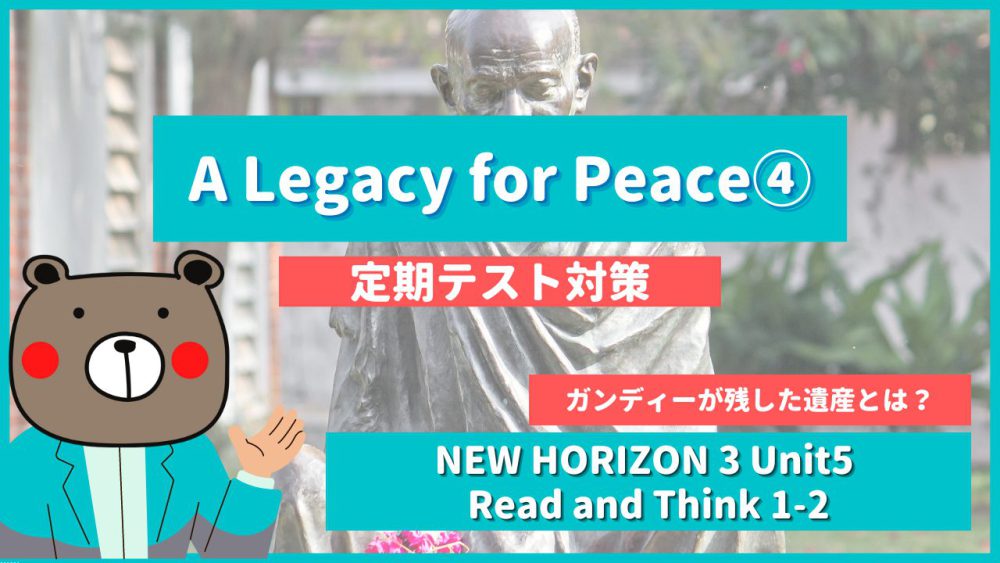

「ピンク」=重要ポイント
▼記号について
V : 動詞 Ving : 動名詞 Vpp : 過去分詞
【 】名詞句・節 〈 〉形容詞句・節 ( )副詞句・節
S:主語 O:目的語 C:補語 M:副詞
【1】What is the main idea of Gandhi’s movement?
《和訳》
ガンディーの活動の主な考えはなんですか?
《重要ポイント》
「the main idea of Gandhi’s movement」= ガンディーの活動の主な考え
・「the main idea」= 主な考え
・「of ~」= ~の
・「movement」= 運動・活動
【2】Gandhi returned to India in 1915.
《和訳》
ガンディーは1915年にインドに戻ってきました。
《重要ポイント》
「returned」= 「return(戻る)」の過去形
「in 1915」= 1915年に
・年月など比較的期間の長い時間を表す場合は「in」
(例)in August(8月に)
【3】India was also a British colony.
《和訳》
インドもまたイギリスの植民地でした
《重要ポイント》
「also」= ~もまた
「British colony」= イギリスの植民地
・「British」= イギリスの
・「colony」= 植民地
【4】In those days, there was a law that the British made for salt.
《和訳》
当時、イギリス人が塩のために作った法律があった。
《重要ポイント》
「in those days」= 当時、そのころ
「there was a law that the British made for salt」= イギリス人が塩のために作った法律があった。
・これは今回の最重要ポイント❗️
・目的格の関係代名詞「that」です。
・ちなみにUnit5-1と同じで、この関係代名詞は省略できます❗️
・⇩みたいに、「人・人以外の両方」について説明を加えるときに使います!
① There were a law.(法律がありました)
② The British made a law for salt.(イギリス人が塩のために法律を作った)
・「a law」がかぶっているので、②の「a law」を「that」で置き換えて、②の文の先頭に「that」を持ってきて①②をつなぐ❗️
「there was a law that the British made for salt」
・すると「《イギリス人が塩のために作った》法律がありました」となり、
・①②の文が一つになります❗️
「law」= 法律
「salt」= 塩
【5】According to the law, only the British could produce or sell salt.
《和訳》
その法律によると、イギリス人だけが塩を生産したり、売ることができた。
《重要ポイント》
「According to the law」= その法律によると
・「according to ~」= ~によると
「only the British could produce or sell salt」= イギリス人だけが塩を生産したり、売ることができた
・「only」= ~だけ
・「could」= 「can(〜できる)」の過去形
・「produce」= ~を生産する
・「sell」= ~を売る
【6】They put a heavy tax on it.
《和訳》
彼らはそれに重い税金を課しました。
《重要ポイント》
「put a heavy tax on it」= それに重い税金をかける
・「put a tax on ~」= ~に税金をかける
・「heavy」= 重い
・この「it」は塩のことを指しています❗️
【7】The Indians were very poor, but they had to buy expensive salt.
《和訳》
インド人はとても貧しかったけど、彼らは高価な塩を買わなければならなかった。
《重要ポイント》
「poor」= 貧しい、かわいそう
「they had to buy expensive salt」= 彼らは高価な塩を買わなければならなかった
・「had to V(動詞の原形)」= 「have to V(Vしなければならない)」の過去形
・「buy」= ~を買う
・「expensive」= 高価な
【8】The money went to the British.
《和訳》
そのお金はイギリス人に行きました(渡りました)。
《重要ポイント》
ここは特になし❗️
【9】Gandhi thought it was unfair.
《和訳》
ガンディはそれは不公平だと思いました。
《重要ポイント》
「Gandhi thought it was unfair」 = ガンディはそれは不公平だと思いました。
・「thought」= 「think(~を思う)」の過去形
・「think + S(主語) + V(動詞)」= SがVすると思う
・「unfair」= 不公平な
【10】In 1930, Gandhi decided to walk to the sea and make salt himself.
《和訳》
1930年、ガンディーは海へ歩き、自分自身で塩を作ることを決めました。
《重要ポイント》
「Gandhi decided to walk to the sea」 = ガンディは海へ行くことを決めました
・これは「to + V(動詞の原形)」で表す不定詞の名詞的用法(〜すること)です!
・つまり「decide to walk」= 歩くことを決める
・「decided」= 「decide(〜を決める)」の過去形
・「walk to the sea」= 海へ歩く
「and make salt himself」 = 彼自身で塩を作る
・「himself」= 彼自身
・「and(〜と、そして)」は等位接続詞で同じもの(節・文・語など)をつなぐ
・この文では、「walk to the sea」と「make salt himself」を繋いでいる❗️
・なので省略せずに書くと…
①Gandhi decided to walk to the sea.
②Gandhi decided to make salt himself. となり、
・決めたことが二つあることがわかる🐻
・いや〜、等位接続詞(and, or, butなど)は奥が深い!!
【11】He started with 78 followers.
《和訳》
彼は78人の支持者とともに始めました。
《重要ポイント》
「started」 = 「start(始める)」の過去形
「with」 = ~とともに、一緒に
「78 followers」 = 78人の支持者
・「follower」= 支持者
【12】Thousands of people joined him on the way.
《和訳》
途中で何千人もの人々が彼に加わりました。
《重要ポイント》
「Thousands of people joined him」 = 何千人もの人々が彼に加わりました
・「thousand of ~」= 何千もの〜
・「joined」= 「join(参加する、加わる)」の過去形
「on the way」 = 途中で
【13】After walking almost 400 kilometers, he reached the sea.
《和訳》
約400キロほど歩いた後、彼は海に到着しました。
《重要ポイント》
「After walking almost 400 kilometers」 = 約400キロほど歩いた後で
・「after ~」= ~の後で
・「almost」= 約〜、〜ほど
・「kilometer」= キロメートル
「he reached the sea」 = 彼は海に着きました
・「reached」= 「reach(〜へ着く)」の過去形
【14】This non-violent march was called the Salt March.
《和訳》
この非暴力の行進は塩の行進と呼ばれました。
《重要ポイント》
「This non-violent march」 = この非暴力の行進
・「non-violent」= 非暴力の
・「march」= 行進
「call O C」 = OをCと呼ぶ
・これが使われているのは意外と気付きづらいです💦
・この文は「be + Vpp(過去分詞)」で表す受動態が使われてます❗️
・be = was, Vpp = called です。
*なぜ、Vppが過去分詞を表すかを知りたいマニアックな方はこちらをみてね
・そして、受動態を能動態に戻すと…
・「People called this non-violent march the Salt march.」となり、
・「call O C」(O = this non-violent march, C = the Salt march)が使われてることが分かりますね❗️
【15】News of the march spread around the world.
《和訳》
その行進のニュースは世界中に広がりました。
《重要ポイント》
「News of the march」 = その行進のニュース
・「news」= ニュース
・「of ~」= ~の
「spread」 = 広がる
・「spread」は、現在も過去も過去分詞も同じ形です❗️
・spread《現在》 – spread《過去》 – spread《過去分詞》
【16】It showed people a new way to fight against discrimination.
《和訳》
それは人々に差別に反対して戦うための新しい方法を示しました。
《重要ポイント》
「It showed people a new way」 = それは人々に新しい方法を示しました
・「showed」= 「show(~を示す)」の過去形
・「show A B」= AにBを示す
・この文では、A = people, B = a new way となってます❗️
「a new way to fight against discrimination」 = 差別に反対して戦うための新しい方法
・これは「to + V(動詞の原形)」で表す不定詞の形容詞的用法(〜するための)です!
・「a new way」を後ろから「to fight against discrimination」を加えて説明してます❗️
・つまり、「《差別に反対して戦うための》新しい方法」ってなりますね。
・「way」= 方法
・「fight」= 戦う
・「against」= 反対して
・「discrimination」= 差別
【17】Gandhi’s peaceful fight continued after that.
《和訳》
ガンディーの平和の戦いはその後も続きました。
《重要ポイント》
「Gandhi’s peaceful fight continued」 = ガンディーの平和の戦いは続きました
・「peaceful」= 平和な、平和の
・「fight」= 戦い
・「continue」= 続く
【18】In 1947, India won independence.
《和訳》
1947年、インドは独立を勝ち取りました。
《重要ポイント》
「India won independence」 = インドは独立を勝ち取りました
・「won」= 「win(勝つ、勝ち取る)」の過去形
・「independence」= 独立
【19】Non-violent protest is the legacy that Gandhi left.
《和訳》
非暴力の抗議はガンディーが残した遺産です。
《重要ポイント》
「Non-violent protest is the legacy that Gandhi left.」= 非暴力の抗議はガンディーが残した遺産です。
・これは今回の最重要ポイント❗️
・目的格の関係代名詞「that」です。
・ちなみにUnit5-1と同じで、この関係代名詞は省略できます❗️
・⇩みたいに、「人・人以外の両方」について説明を加えるときに使います!
① Non-violent protest is the legacy.(非暴力の抗議は遺産です)
② Gandhi left the legacy.(ガンディーは遺産を残しました)
・「the legacy」がかぶっているので、②の「the legacy」を「that」で置き換えて、②の文の先頭に「that」を持ってきて①②をつなぐ❗️
「Non-violent protest is the legacy that Gandhi left.」
・すると「非暴力の抗議は《ガンディーが残した》遺産です」となり、
・①②の文が一つになります❗️
「protest」 = 抗議
「legacy」 = 遺産
「left」 = 「leave(〜を残す)」の過去形
【20】It has influenced famous leaders, such as Martin Luther King, Jr. and Nelson Mandela.
《和訳》
それはマーティン・ルーサー・キング・ジュニアやネルソン・マンデラのような、有名な指導者に影響を与えてきています(与え続けています)。
《重要ポイント》
「It has influenced famous leaders」 = それは有名な指導者に影響を与え続けています
・「have + Vpp(過去分詞)」で表す現在完了の継続用法❗️
・「influenced」= 「influence(〜に影響する)」の過去分詞
・「famous」= 有名な
・「leader」= 指導者
「such as ~」 = ~のような


これで全て終了です❗️
「NEW HORIZON-中3《Unit5-Read and Think1-2》」おつかれさまでした🐻
Unit5-Read and Think1は、p76~77と2ページにも続く長文なので、2回に分けました!今回は、p77の後編でした。
目的格の関係代名詞「that」が出てきつつ、単語のレベルが高いので、理解するのがなかなか苦戦したのではないかと思います❗️
ですので、分かったつもりにならずに、復習&音読するのをお忘れなく!!
①授業前にひとこと、でも話しましたが…
⇧に載せてあります『単語・和訳・英作文トレーニング』をテスト1週間前から毎日やってみてください❗️曖昧な理解がなくなり、成績が爆伸びします!!
最後まで見てくださってありがとうございました!
またお会いしましょう!定期テストがんばれ〜🐻
じゃあね〜、バイバイ!!


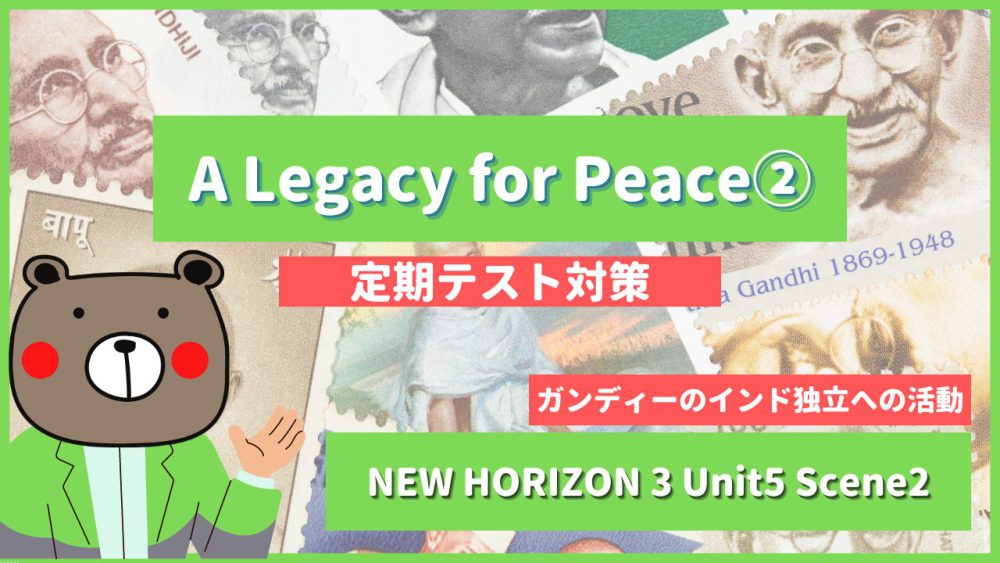
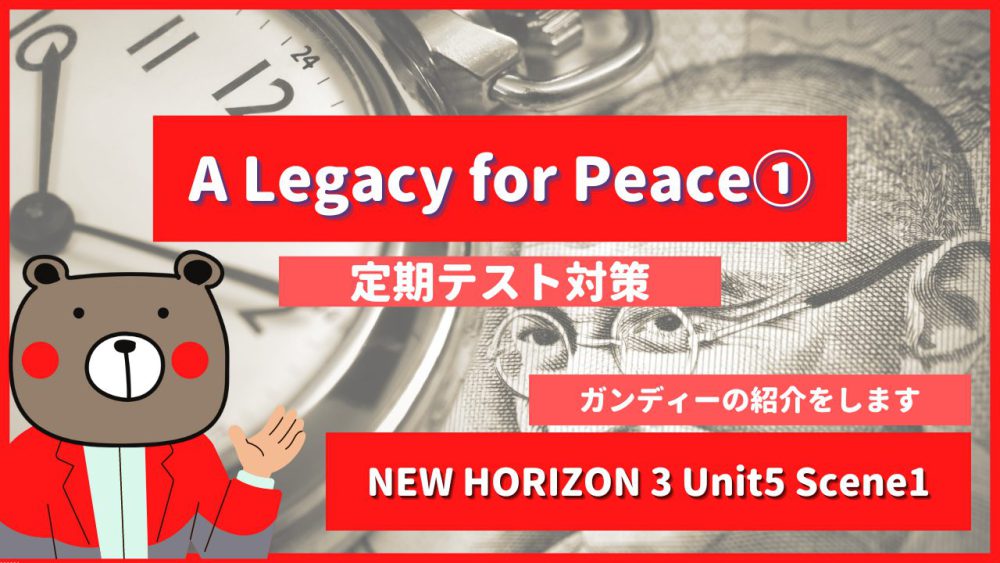


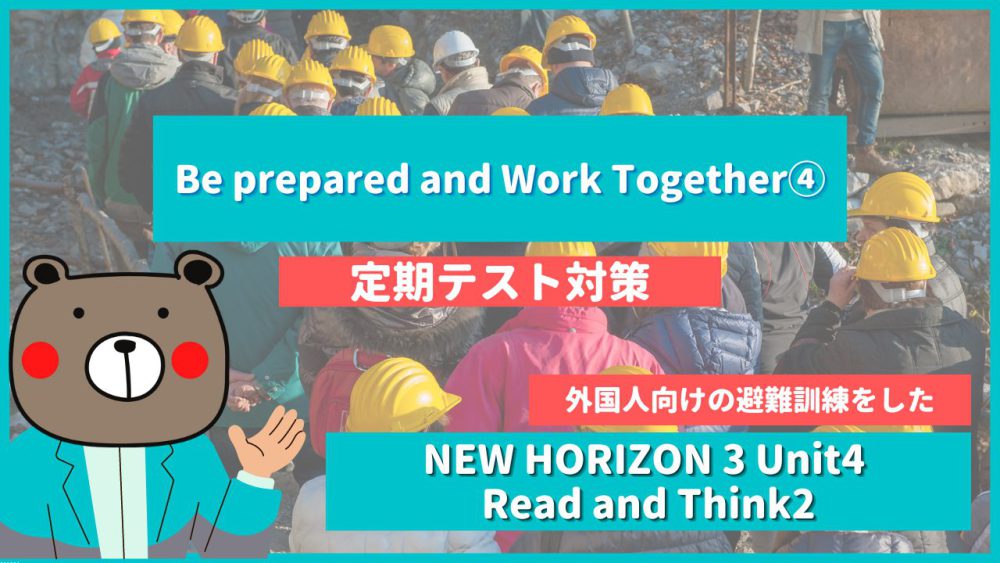


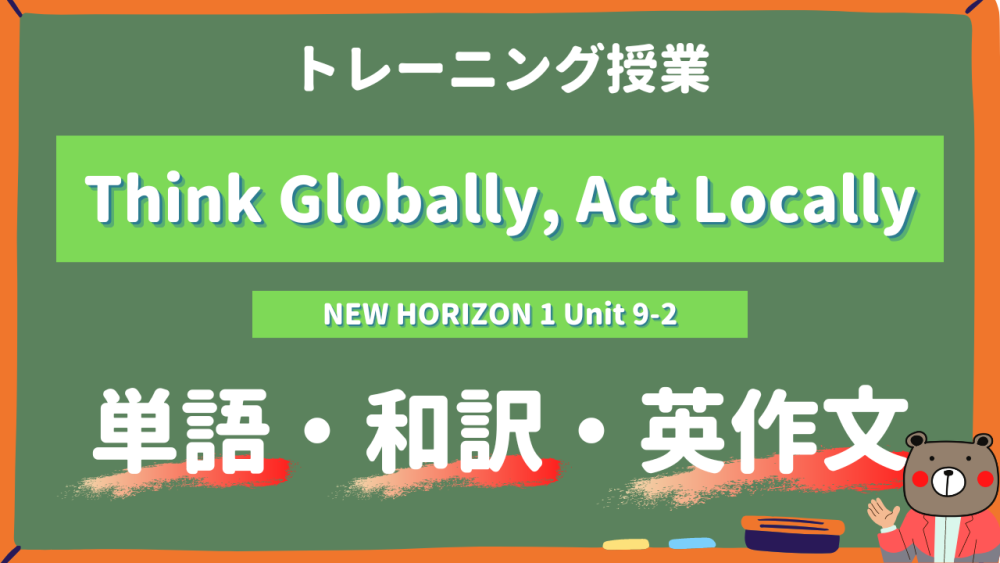
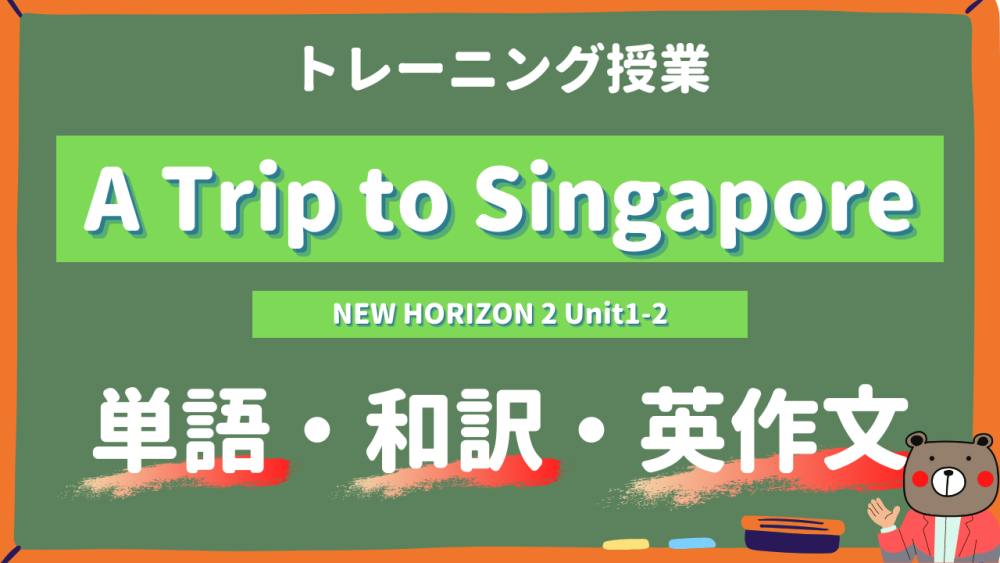
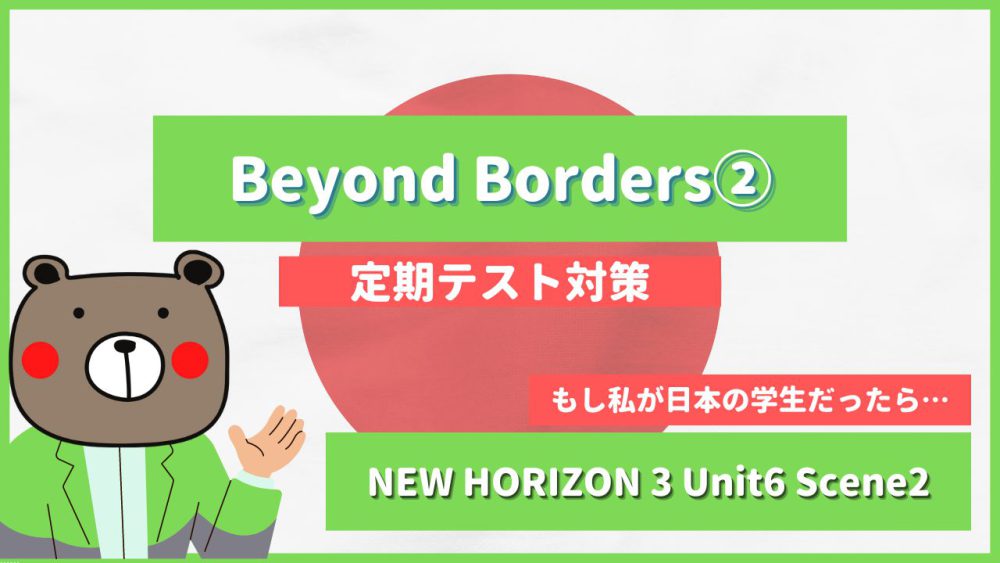

「4」のIn those days, there was a law that the British made for salt.
《和訳》
当時、イギリス人は塩のために作った法律があった。
イギリス人はではなく が が正しいと思います
素晴らしいコメントありがとうございます!
修正完了しました!
引き続き、勉強頑張ってください!
この中に出てくる指示語のitの意味が知りたいです(;;)
(例えばGandhi thought it was unfairの部分やIt has influenced…のところです! )